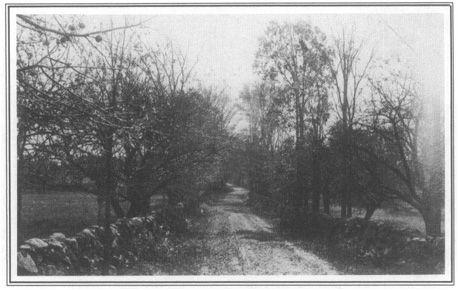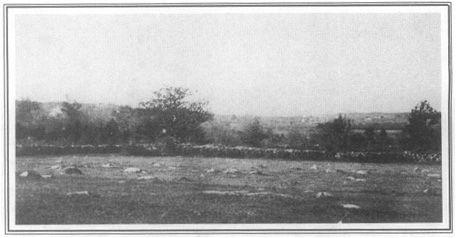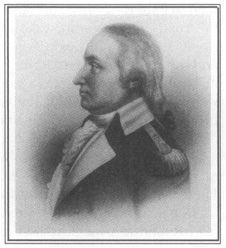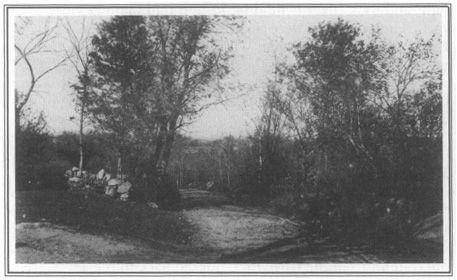Paul Revere's Ride (39 page)
Read Paul Revere's Ride Online
Authors: David Hackett Fischer
Tags: #General, #Biography & Autobiography, #History, #United States, #Historical, #Revolutionary Period (1775-1800), #Art, #Painting, #Techniques

The fighting grew heavier near the Brooks Tavern. Here a company from Bedford had cut across the the “great fields” at Meriam’s Corner. They were in the “thickest of the fight near the Brooks Tavern.” The Bedford men may have lost several men there, killed in action, and others wounded.
71
On the north side of the road, other men from Bedford, Chelmsford, Billerica, and Reading joined the battle, firing from rough pastures and treelines, and forming in little knots around grizzled veterans of colonial wars. The Chelmsford militia were led by Sergeant John Ford at Brooks Hill. A comrade remembered that Ford “was prominent on the hill. He was an old fighter of the French and Indians, and knew how to handle his musket to an advantage.” Sergeant Ford’s musket was seen to bring down five British soldiers that day. Even this veteran was shocked by the growing intensity of the fighting along the Battle Road. Later he and another old campaigner said that “the day was full of horror to them. The Patriots seemed maddened and beside themselves.”
72
Smith disengaged his force and drove it forward through the ambush. Beyond Brooks Hill the road descended into the valley of Tanner’s Brook, then begin to climb steeply again to a higher hill. As it did so, it entered another patch of woods, and turned sharply to the north—dangerous terrain for the British column. Here, in a “young growth of wood” at the bend in the road, another ambush was organized by militia from a fresh New England regiment, who came running to the action from the north. These were Woburn men, 200 strong. Their commander was Major Loammi Baldwin, a leader of high ability. Later Baldwin wrote, “We proceeded down the road and could see behind us the regulars following. We came to Tanner Brook, at Lincoln bridge, and then concluded to scatter and make use of the trees and walls for to defend us, and attack them.” With a good eye for the ground, he chose a position on a wooded rise near the bend on the south side of the road.
73
Other Americans ran to take up positions in the woods on the north side of the highway. Reading militiaman Edmund Foster remembered, “We saw a wood at a distance, which appeared to lieon or near the road the enemy must pass. Many leaped over the wall and made for that wood. We arrived just in time to meet the enemy. There was then, on the opposite side of the road, a young growth of wood well filled with Americans.”
74

The Battle Road, looking east beyond Meriam’s Corner. This glass-plate negative was made by Concord photographer Alfred Hosmer in the 19th century. The narrow highway ran between fields and pastures, with stone walls and fruit trees by the edge of the road. A few apples may be seen still on the trees in the upper left. (Concord Free Public Library)
The Regulars approached rapidly. In the van was the light infantry of the 10th Foot. Its commander, Captain Parsons, was the only officer still unwounded in his company. Behind them came the light infantry of the 5th Foot, and what remained of the King’s Own. The head of the British column reached the bend in the road.
As the British van began to turn the corner, Major Baldwin ordered his Woburn men to fire. From the other side of the road, the Reading men attacked as well. The Regulars were caught in a deadly crossfire and suffered grievously. Foster recalled that “the enemy was now completely between two fires, renewed and briskly kept up. They ordered out a flank guard on the left to dislodge the Americans from their posts behind large trees, but they only became a better mark to be shot at.”
75
Many Regulars were killed or wounded. Once again the Americans aimed at the officers. In the light Infantry of the 5th Foot, every officer but one was hit. Only one officer in the Fourth remained unscathed. The British sergeants took over their companies, rallied the men, and led them forward directly into the brush with the valor that these weary men displayed all day.

The terrain north of the Battle Road appears in this artless 19th-century photograph by Alfred Hosmer. The camera faces west toward Concord, across an open landscape of rock-strewn pastures, high stone walls, tree lines, and farming hamlets. (Concord Free Public Library)
The Regulars drove through the ambush in savage fighting, only to meet another one 500 yards beyond, where the road came to another sharp bend at a large “woodpasture.” Here another large force of militia arrived from the east and north, and joined other New England men who had run through a country lane north of the highway. The Americans used cover skillfully, and lost only four men. The British infantry fought with dogged courage in the open road, and lost thirty killed and wounded in this deadly stretch of road that came to be remembered as the Bloody Curve.
76
While Loammi Baldwin’s Woburn companies engaged the head of the British column from the right, and the men of Reading attacked from the left, another fresh American regiment from Westford, Stow, and Groton attacked the rear. At the same time, Colonel Barrett’s Concord men and three other regiments fired into the column from the northwest.
77
The British troops came through the Bloody Curve at a trot, faster than the Americans could make their way through the swamps and woods beside them. As the Regulars kept moving, the American troops, now more than 2000 strong, converged behind them on the highway and became so entangled that control was lost. That disorder allowed the British column to get clear.
78

Major Loammi Baldwin, thirty years old, was another field-grade officer who gave direction to the battle. He led three companies from Woburn, and organized the deadly ambush that gave the Bloody Curve its name. As the British column retreated in growing disarray, Baldwin led his men in pursuit, so close that he was nearly killed by Percy’s cannon. (Hurd,
History of Middlesex County)
East of the Bloody Curve, the road passed into open farmland. Colonel Smith got his flankers out again, and kept the American soldiers at bay, but not for long. The road curved to the south, past the farms of Ephraim and Samuel Hartwell. Here more militia companies from Bedford, Woburn and Billerica joined the fight and took cover behind barns and outbuildings close to the road. Their numbers were small, but they were aggressively led by Bedford’s Captain Jonathan Wilson, who had little respect for his enemies and a great desire for close combat. Earlier that morning, when he and his men stopped on their march at the Fitch Tavern in Bedford, he was heard to boast, “We’ll have every dog of them before night.”
79
Wilson placed his men behind a barn on the Hartwell farm, very close to the road. They waited until the long red column approached, then fired directly into the van with deadly effect. As the Americans reloaded, a flanking party of British grenadiers caught the militia from behind. Captain Wilson was killed, and Lieutenant Job Lane was severely wounded. With the Bedford men was Woburn militiaman Daniel Thompson, who fired into the column from the barn, then ducked back to reload. A grenadier came around the corner of the building, and shot him. Another Woburn man shot the grenadier, who fell dying in the Hartwell yard.
80
Beyond the Hartwell farm the British force continued to lose
men to long range fire and skirmishes around homes by the side of the road. The column was now approaching the boundary between Lincoln and Lexington. To the south, the terrain was low and wet. North of the road was a pasture studded with large granite boulders. Beyond it was a steep rocky hillside, part of a five-acre woodlot that belonged to the farm of Tabitha Nelson. The road headed directly toward the hill, then veered south around it.
81
Waiting on the hill was a band of Yankee militia with a score to settle. They were Captain John Parker’s Lexington company— many of the same farmers who had stood on their town green. Parker had rallied them after their shattering defeat and brought them back into combat—an extraordinary feat of leadership. He led his men westward to the Lexington-Lincoln line, and some of his company took positions in the granite-strewn pasture on the north side of the road just within the town of Lincoln. They found cover in drainage ditches and large stone outcroppings, alongside the Lincoln militia. As the British column approached, the New England men fought stubbornly from behind the great gray boulders. Lincoln’s William Thorning, a crack shot, opened fire from a drainage ditch, retreated to the cover of a large rock, and fired again, killing two Regulars. A British flanking party cleared the ground, but at a cost. More men were killed and wounded.
82

The Bloody Curve was a series of engagements at two sharp turnings in the highway on wooded ground. This 19th centurv photograph by Alfred Hosmer shows the intersection of the Bedford Road (left) and the portion of the highway that is now called Virginia Road. The militia were in the trees to the left and right. (Concord Free Public Library)
Just ahead, Captain Parker and the rest of his Lexington company waited on the rocky hill where the road entered their town. Some of the men wore bloody bandages over stiffening wounds they had received that morning. Others were blackened by powder smoke. They knelt grimly on their steep wooded hillside behind large granite boulders as the Regulars approached.
83
The Lexington men held their fire until the van of the British column came very close to their position. Then, as Colonel Smith himself rode up, Parker ordered them to fire. Smith tumbled out of the saddle, painfully wounded in the thigh. Captain Parsons, the last unwounded officer of the 10th Foot, was hit. So great was the shock of this attack that the British column stopped for a moment, compressing on the road. Major Pitcairn came galloping up, and sent the British infantry charging forward up the rocky hillside, driving Parker’s militia away from the road. Now the Americans began to take casualties. Lexington’s Jedidiah Munroe, wounded in the morning, was killed. The American ambush was cleared, but more Regulars were dead and wounded on a rocky hillside that is remembered as Parker’s Revenge.
84
